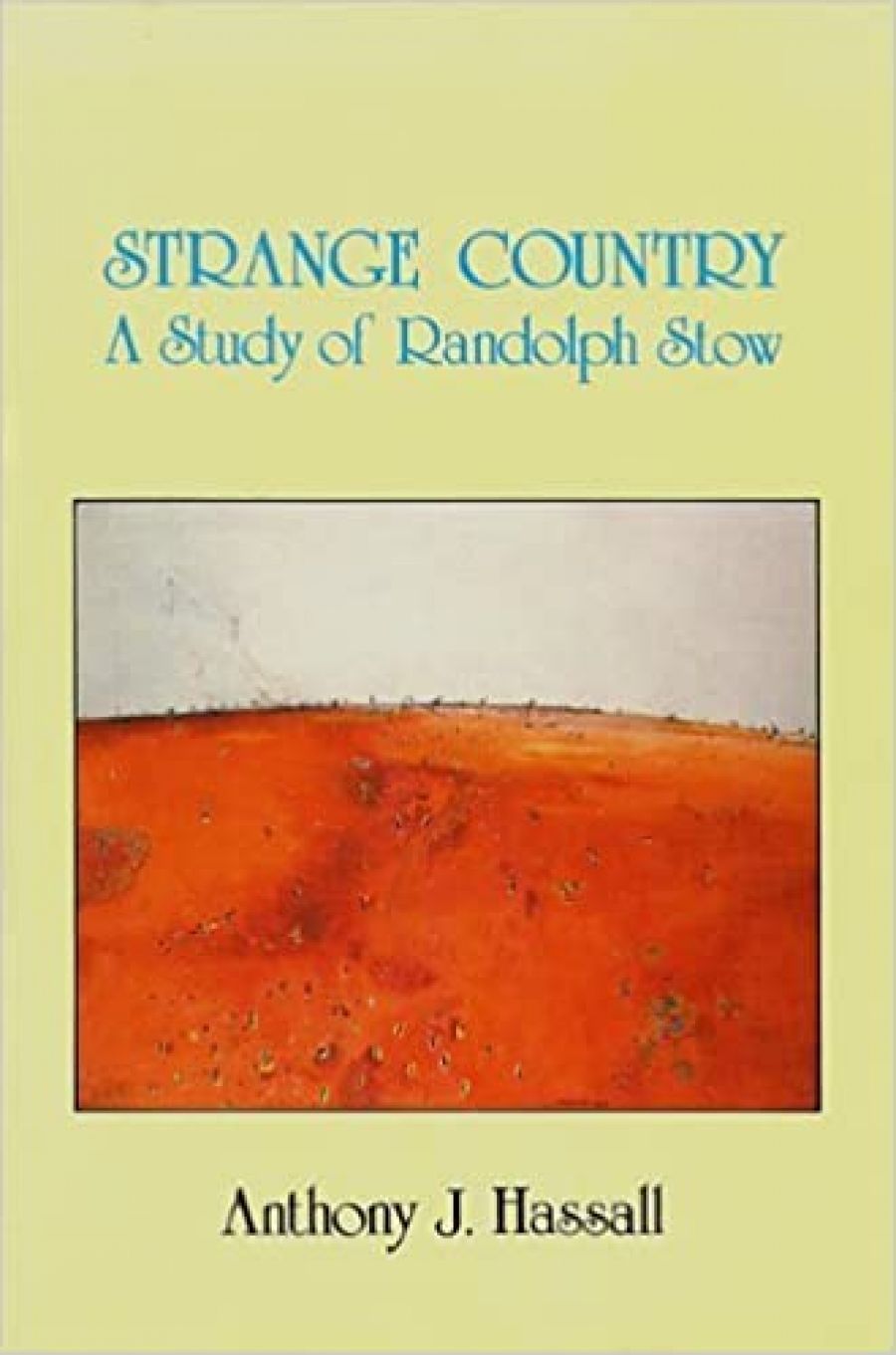
- Free Article: No
- Contents Category: Literary Studies
- Review Article: Yes
- Online Only: No
- Custom Highlight Text:
Professor Hassall’s study of Randolph Stow is indeed a strange country. A text which sets out to establish Stow as ‘a more important writer than is generally recognized’ and to show that his ‘best work bears comparison with Patrick White’s’ promises an intellectual engagement with either critics or the text or both which would lead to reassessment of Stow’s work. It appears that these are Aunt Sally’s – although Professor Leonie Kramer, who is presented as one of Stow’s ‘sterner “realist” critics’, can hardly be seen as such an aunt. Hassall puts her up but barely touches her, leaving the counterargument to Dorothy Green. Perhaps he’s being gentlemanly. However, to quote a paragraph from Green which asserts that ‘One of the greatest weaknesses of Australian criticism has always been its refusal to take religious ideas seriously’ is to take advantage of the lady. Hassall needs to fight his own battle against Leonie Kramer’s judgement of Stow’s work as being ‘quasi-religious’ and misguidedly experimental.
- Book 1 Title: Strange Country
- Book 1 Subtitle: A study of Randolph Stow
- Book 1 Biblio: University of Queensland Press, 207 pp, $30.00 pb
Hassall’s ‘critical reading of all (Stow’s) works to date’ begins with an appraisal of ‘The Landscape of the Soul’ of the writer and then proceeds to individual works. In this he is thorough. He looks hard, he looks closely, but unfortunately through a veil of text which thickens as we gaze:
When Tom Spring later points out his similarity to: ‘These black-and-white men … these poor holy hillbillies who can only think in terms of God and the devil’, the law protests; ‘I’m not like that!’ and Tom replies: ‘Aren’t you? … Well, by heaven, you used to be’ (p.185). Tom at this point is trying to ‘cure’ the law – who has forgotten that he has been cured once already – of his shallow morality and his susceptibility to Random, who is perceived by Tom as self-torturing, guilt ridden and destructive.
Throughout his study, Hassall has an eye on the innocent reader ignorant of Stow’s oeuvre and therefore feels obliged to supply a running Reader’s Digest account of each story. Undergraduates will be grateful for this approach.
Sometimes Hassall gives too much information, sometimes too little, but too often he takes for granted that certain values are shared bread and all that is necessary is to show how well Stow presents the repast. In his introductory chapter, ‘Landscape of the Soul’, Hassall claims that ‘Stow is a private rather than a social novelist, less interested in interpersonal relationships than in his characters’ relationship with themselves and with God’. Hassan may have confirmed this with Stow for there appears to be a lot of fatherly confirmation going on in the endnotes. However, even in his own account of the novels, this ‘truth’ is strained. By the end of his critical reading of the texts, Hassell has shown that it is the failure of interpersonal relationships which has dried the landscape of the soul in the protagonists.
Although Hassall may wish to see Stow as a metaphysical writer, it seems to me that Stow is very much concerned with social guilt: with taking on of responsibility for the sins of the white colonial fathers. The novels present a much harsher critique of the rod held by Christianity to convert the conquered to the cargo cult than Hassall allows. To comment that ‘Like Patrick White, [Stow] is a religious writer without a defined ideology, and it does not do to press the text for certain certainties’ is to do Stow a disservice. There may not be certainties about certain aspects of the text, but as Hassan himself points out, Stow rejects a Christian God, moves to Taoism and comes to a relatively peaceful rest in the pagan Green Man and the amorality of The Girl Green as Elderflower. In this novel, Stow’ s portrayal of Jim-Jacques, a Prodigal Jesuit priest, is a sympathetic forgiving of Christianity’s failings. But Stow’s forgiveness is not a return to the fold even if his return to the green and pleasant land from the prophetless deserts of Australia and the lush jungle of confusion of the Trobriand Islands has been a journey to find his spiritual home. As a moral movement this has been a significant journey. Hassan explicates very thoroughly the inherent duality evident in Stow’s work. He draws on Martin Boyd and Patrick White for parallels and concludes that there has been a partial reconciliation, ‘a hard-won serenity of sorts’, which ‘is clearly related to the experience of settling in England’.
By giving a structuralist reading, by showing the repetition of motifs, by insisting that Stow is not a ‘social realist’ (this appears to be used rather loosely) but a poetic realist expert in the use of dialogue, Hassan elucidates what is achieved by Stow. However, by not asking the hard questions of Stow’s work, the nature of ‘religion’ being embraced, the kind of relationship Stow sees between Taoism and social organizations within white civilisation, the implications of embracing the girl green as elderflower, Hassall dissipates the assessment of Stow’ s reputation. A critical approach which looks at Stow’s work from a more controversial position than a metaphysically safe one may confront more fully the nature of the ambiguities inherent in Stow’s selection of myths through which he structures his work and also might do more to thrust Stow into academic limelight.


Comments powered by CComment